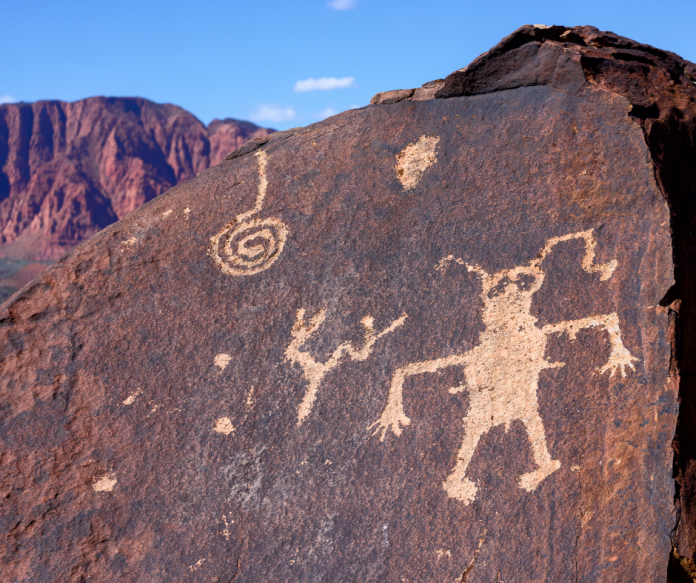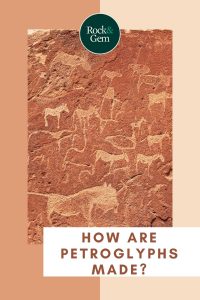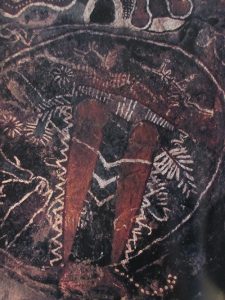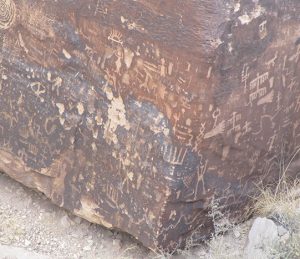
How are petroglyphs made? The two basic forms of rock art are pictographs, which are pigments applied to rock surfaces, and petroglyphs, or engravings.
Rock art, which is defined as ancient, man-made markings on natural stone, is a global phenomenon that spans thousands of years, divergent cultures and entire continents. Because pictographs and petroglyphs are artifacts that offer insight into the symbols, religious and belief systems, and origins of abstract and figurative art of past cultures, they are usually considered in an archaeological context.
Art and Minerals
But no less interesting is the mineralogy behind rock art—specifically the pigments utilized in pictographs and the rock varnish into which most petroglyphs are engraved.

Rock art is found throughout North America, but is most abundant and prominent in the arid, exposed-rock landscapes of the greater Southwest, including Southern California, Arizona, Nevada, New Mexico, Utah, Colorado, and western Texas, where thousands of sites are decorated with pictographs and petroglyphs.
Arizona’s federal lands alone have more than 2,500 rock art sites, a few with only a single image, others with hundreds and even thousands of images. The largest rock art concentration in the Western Hemisphere is in Southern California’s Cosos Mountains, where basalt cliffs are adorned with more than 100,000 petroglyphs. Utah has at least 7,000 rock art sites, while New Mexico’s Petroglyph National Monument alone has 25,000 petroglyph images.
While rock art images are prehistoric artifacts, they have nevertheless had a profound influence on contemporary Southwestern art and culture. New Mexico’s state flag design, a sun with four rays representing the four directions, four times of day, four stages of life, and four seasons, is taken from a Zia petroglyph. Rock art images of lizards, howling coyotes, bighorn sheep, and sun spirals are popular motifs in everything from modern wall hangings and pottery designs to coffee cups, lawn ornaments, and corporate logos.
Iconic Southwest Rock Art
Perhaps the most celebrated rock art image is that of “Kokopelli”, the flute-playing, hunchbacked Hopi deity of reproduction and music, which has evolved into an immediately recognizable, graphic symbol for the entire Southwest.

While archaeologists and anthropologists ponder the purpose and meaning of rock art, mineralogists study its physical features. In the North, Midwest, and East, Native American artists used hard, quartz-based rocks to engrave petroglyphs into relatively soft limestone and sandstone surfaces. A well-known example in the East is Dighton Rock, a 40-ton sandstone boulder covered with deeply carved petroglyphs that is now displayed at Dighton Rock State Park in southeastern Massachusetts.
But in the Southwest, petroglyph artists engraved sandstone only occasionally, performing most of their work instead on far harder rocks such as basalt, which is common in the regional deserts and canyons. These shallow engravings depend not on depth for their visual impact, but on color contrast. The critical element in Southwestern petroglyphs is rock varnish, the thin, dark coating that forms on rock surfaces over long periods of time.
Rock varnish is most familiar as the dark, vertical stains that dramatically decorate canyon walls and cliffs throughout the Southwest.
Examining Rock Varnish

German geographer and explorer Alexander von Humboldt made the first historical mention of rock varnish in 1799 when he visited Venezuela and wrote of granite boulders that appeared “smooth, black, and as if coated with plumbago”. At the time, plumbago referred to graphite, a black, crystalline form of elemental carbon. Indigenous tribesmen told von Humboldt that the hot, tropical sun had burned the boulders to blackness, one of the many early guesses as to the origin of the strange coating.
Similar coatings observed on rocks worldwide became the subject of a mineralogical mystery that lasted for nearly two centuries. Early theories about the origin of rock varnish ranged from deposits left by ancient seas, residues of decomposing organic matter, and the chemical “rusting” of rock surfaces. By the late 1800s, mineralogists began focusing on a process in which the sun and heat supposedly caused mineral-rich water to “sweat” out of rocks, evaporate, and precipitate a dark mineral coating.
By the 1920s, mineralogists suspected that rock varnish consisted largely of iron and manganese oxides, a theory that could not be proved because the oxide particles were too fine to be studied by the analytical methods that then existed. Some mineralogists even proposed the innovative idea that rock varnish formed when direct sunlight somehow combined with microbial action to cause dark-colored iron and manganese oxides from the interior of rocks to concentrate on their surfaces.
That idea persisted until the late 1970s, when advanced analytical methods, coupled with some brilliant, scientific detective work, finally unraveled the mystery of rock varnish’s origin. In the first step, researchers determined the actual composition of rock varnish. It was found to be a thin coating only a tiny fraction of a millimeter thick—about that of a human hair—consisting of 60% clay minerals and 20 to 30% iron and manganese oxides, the latter mainly birnessite (hydrous sodium calcium manganese oxide), goethite (basic iron oxide), and hematite (iron oxide). The remaining portion is a mix of some 30 minor compounds.
Influence of Manganese on Varnish
Researchers also learned that the manganese content of rock varnish was as much as 100 times greater than that of nearby rocks and soils, and that high concentrations of manganese-based minerals created rock varnish’s dark color. Rock varnish with high levels of manganese oxides is nearly black; lower levels of manganese oxides (and thus higher relative proportions of hematite) produced a brown or orange-brown color.

Researchers then attempted to piece together the origin of rock varnish. In 1979, Arizona State University professor of geography Dr. Ronald Dorn and his colleagues employed scanning electron microscopy on hundreds of rock varnish samples from different sources. All specimens were observed to contain manganese-concentrating bacteria of the genus Metallogenium, a find that suggested a biological origin for rock varnish.
Again employing scanning electron microscopy, Dorn and his researchers discovered a distinct morphological boundary between the rock-varnish coating and the host rock. This absence of any compositional gradient showed that rock varnish is actually an accretion of materials that originates not from the interior of the rock, but which accumulates from extraneous sources. This discovery was the final piece of the puzzle that explained the origin of rock varnish.
Rock varnish begins to form when fine, wind-blown clay particles and smaller particles of iron and manganese compounds gradually collect on rock surfaces to form thin, porous films. Manganese-concentrating bacteria then absorb and oxidize the metal-bearing particles, precipitating black manganese oxides and reddish-black iron oxides.
Mineral Conversion Contribution
In a complex relationship of water, clay, bacterial action, and mineral compounds, water migrates through tiny pores in the clay, transporting mineral compounds. Metallogenium bacteria convert the iron and manganese compounds into oxides. Along with organic products of bacterial oxidation, these oxides combine with the clay particles to create a durable cementing agent that adheres tenaciously to rock surfaces. This thin, but steadily developing, rock varnish layer shields the bacterial colony from desiccation and intense solar radiation, enabling the layer to eventually build to its full thickness.
Researchers then formally named the dark rock coating that they had investigated. Since the time of von Humboldt, this coating had been variously known as “rock black”, “rock rust”, “rock patina” and, most popularly, “desert varnish”. To dispel the erroneous idea that this coating only formed in desert regions, researchers agreed upon the term that is preferred today: “rock varnish”.
Different rocks have varying abilities to accept and retain rock varnish. Limestone rarely only exhibits rock varnish because it is too water-soluble to provide a stable surface on which the coating can form. The densest and most durable rock varnish forms on basalt, rhyolite, granite, quartzite, and other similar rocks that are highly resistant to weathering.
Although a fully developed rock varnish layer is tissue-paper thin, it can nevertheless alter the color of cliffs, boulder fields, and even entire mountains. On a smaller scale, it can completely disguise the surface appearance of individual rocks. Even a thin layer of rock varnish can make light-colored granite and rhyolite look like dark basalt.
Techniques To Create Petroglyphs
Petroglyphs are created by removing selected areas of dark rock

varnish to expose and contrast with the lighter-colored, underlying rock. Petroglyph artists employed four basic techniques. In “pecking”, they repetitively struck rock surfaces with naturally pointed or flaked stone tools. In “drilling”, they rapidly rotated flaked stone points mounted on wooden shafts. “Scratching” utilized simple back-and-forth movements with sharp stone points; “grooving” was a more precise and deeper scratching technique.
Rock varnish will eventually reform on engraved areas, gradually reducing the contrast of petroglyphs. But because rock varnish develops so slowly, petroglyph images last for thousands of years.
Attempts to date petroglyphs by absolute (direct) and relative (indirect) methods have had only limited success. Direct dating focuses on the growth rate of rock varnish. In the Southwestern climate, a full layer of rock varnish accumulates in roughly 10,000 years.
This makes it possible to roughly estimate the age of the partial coatings on engraved petroglyph surfaces. Unfortunately, the rate of rock-varnish development varies significantly with local climactic or other environmental conditions.
A somewhat more precise dating technique is cation-ratio dating, which determines and compares the degree of leaching of iron, manganese, calcium and potassium cations.
Rock Varnish Helps Date Art
Comparing the degrees of leaching in fully developed rock varnish layers with those in the partial layers on engraved petroglyphs gives a rough idea of when the engraving was made.
Knowing the approximate age of rock varnish not only helps archaeologists date petroglyphs, but also enabled geologists to date such landform-altering events as landslides, glacial movements, and volcanic eruptions.
In relative dating, archaeologists attempt to link petroglyphs to nearby cultural ruins or artifacts of known age—a technique that assumes that the petroglyphs and nearby artifacts or ruins are actually related. Conclusive relative dating is valid only with representational rock art images, such as those depicting Christian crosses and horses, which were obviously made after the Spanish arrived in the Southwest.
Unlike engraved petroglyphs, pictographs are paintings on rock, usually sandstone or limestone with smooth, light-colored, fine-grained surfaces. And while petroglyphs were made in exposed areas, pictographs are found only in cave interiors, on canyon walls, or at the semi-sheltered bases of cliffs, indicating that pictograph artists were clearly aware that their work was vulnerable to direct exposure to the elements.
Pictograph paints consisted of a pigment, a binder, and a fluid. The pigments were minerals, carbonaceous fire residues, clay or shell, all ground to a fine powder. The primary pictograph colors were red, black and white; yellow and blue-green were much less common.
Hematite Headlines Pictographs

The predominant pictograph color is red, which is not surprising considering its high visual impact and the plentiful supply of the hematite, or iron oxide. While the color of crystalline hematite is silvery-gray to near-black, that of particulate hematite is red. The finer the hematite particles, the more intense and bright is their red color. Hematite is chemically stable, impervious to the action of natural acids, and does not fade in sunlight. Red hematite pigments were used extensively in pictographs around the world, most notably in the famed, 30,000-year-old Neolithic cave paintings of southern France.
Black, the next most common pictograph color, is derived from pigments of elemental carbon obtained from fireplace soot or finely ground charcoal or coal. Some black pigments consist of finely ground pyrolusite (manganese dioxide) or similar manganese oxides or hydroxides. Both elemental carbon and manganese oxides are chemically stable and produce jet-black paints.
White pictograph paints contain finely ground white clays, seashells, bones, gypsum (hydrous calcium sulfate), and caliche (a natural calcium-carbonate cement that often coats rocks in arid regions). White pictograph pigments had varying degrees of chemical stability.
An occasional pictograph color is yellow, which is based on a pigment of limonite or ocher, an abundant mixture of hydrated iron oxides.
Regional-Specific Colors
Blues and greens, which are rare in Southwestern pictographs, are largely restricted to regions with outcrops of the green and blue copper carbonate minerals malachite and azurite. Malachite pigments are fairly stable, but those of azurite are not. Because slow, natural oxidation converts azurite into malachite, most of the blue, azurite-based pigments in pictographs have turned to green.
Organic binding agents in pictograph paints—plant extracts and resins, egg whites, and animal fats, to name just a few—enabled the pigments to adhere to rock surfaces. Water gave pictograph paints their proper consistency.

After they were painted, pictographs eventually became covered by thin veils of white or colorless minerals that were naturally deposited by water that trickled down the rock walls. Originating as dew, rain, snowmelt, frost, or seepage from the rock itself, this water carried varying amounts of dissolved silica and calcium. As the water evaporated, it deposited a mineral film called “silcrete”, which is similar to the hard-water deposits that accumulate on plumbing fixtures.
Silcrete can become so thick that it obscures pictographs, but most often it provides a transparent covering that protects the pictograph and helps to fix the pigments to the rock. Under electron microscopes, pictograph cross sections appear as layers of paint “sandwiched” between two silcrete layers. The original silcrete layer, present before the pictograph was made, adjoins the rock surface. Next is the paint itself, atop which is a second, protective silcrete layer that was deposited after the pictograph was made.
As with engraved petroglyphs, attempts to date pictographs have brought only mixed results. Even the results of radiometric, carbon-14 dating of the organic binder materials in pictograph paints are unreliable. The problem is not the carbon-14 method itself, but in being certain that the tiny organic samples in the paints reflect the actual time period in which the pictographs were created.
Impact of Deterioration
While remarkably durable, rock art is not indestructible. Deterioration,

which occurs with each passing year, is both natural and man-made. Natural chemical and physical weathering breaks down rock surfaces and pictograph paints, while new growths of rock varnish slowly obscure petroglyphs.
Man-made deterioration, both unintentional and deliberate, takes a greater toll on rock art. A major form of unintentional deterioration is industry-generated acid rain. But even touching pictographs and contaminating them with skin oils can alter the delicate chemistry of the ancient paints.
Saddest of all is the destruction of rock art by vandals and “collectors” who deface images, attempt to chisel out or otherwise remove them, or “enhance” them with modern marking materials. This situation has become so serious that the policy of federal land-management agencies is now to reveal only the locations of rock art sites that are regularly patrolled. All rock art on federal lands is protected under the Antiquities Act of 1906. States have similar protection laws.
Although we now understand how rock art was made, the question of why it was made remains unanswered. Stylized animal images appearing together with anthropomorphic figures holding weapons were once logically thought to depict hunting-related events.
Symbolism in Pictographs
Geometric images such as circles were thought to be solar or lunar symbols tied to seasonal or astronomical cycles. Lines or combinations of lines were assumed to represent trails, terrain features, and territorial boundaries, or were interpreted as clan symbols or mnemonic devices for important events.
Some early archaeologists even considered rock art to be nothing more than ancient graffiti, an idea now firmly rejected on the grounds that creating images that would endure for centuries or even thousands of years was not a casual activity, but a thoughtful project that demanded a major commitment of time and effort. Many pictographs are often located in nearly inaccessible areas high on cliffs or cave ceilings—places that would not interest casual artists.
Anthropologists now generally agree that most rock art was created by shamans, whose motivations were spiritual and often enhanced by hallucinogenic trances. All ancient Native American cultures employed rituals, magic and spiritualism to explain nature’s many dualities, such as life and death, day and night, and summer and winter. Rock art can thus be explained as graphic expressions of belief systems that were established in attempts to control these dualities.
While their exact meaning may always remain uncertain, we at least understand the basic mineralogy behind the Southwest’s countless rock art images.
This story about how are petroglyphs made previously appeared in Rock & Gem magazine. Click here to subscribe! Story by Steve Voynick.













